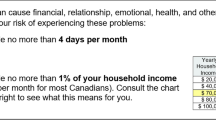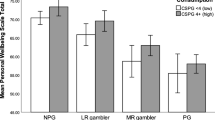Abstract
The study looks at three representative samples of Norwegians in different age groups with the aim of finding evidence for the validity of the total consumption model for the area of gambling. The results show that gambling was distributed in the population in a way consistent with the predictions of the total consumption theory. Populations with a low mean gambling frequency had a lower proportion of frequent gamblers than populations with a high mean gambling frequency. It was also shown that in a population with a low mean gambling frequency, consumers along the whole consumption continuum gambled less frequently, than in a population with a high mean gambling frequency. It is concluded that the total consumption model seems to be valid for gambling, and that gambling consequently needs to be understood as a public health issue. The actions and behaviours of the normal majority can then not be regarded as irrelevant for the development in problem gambling prevalences.





Similar content being viewed by others
Notes
Even though gambling is normally thought of as a behaviour, it is here regarded as a “good” or service that is bought, hence the somewhat unfamiliar use of the word consumption.
References
Abbott, M. (2005). Disabling public interest: Gambling strategies and policies for Britain: A comment on Orford 2005. Addiction, 100(9), 1233–1235.
Abbott, M. (2006). Do EGMs and Problem Gambling go together like a Horse and Carriage? Gambling Research, 18(2), 7–38.
Babor, T., Caetano, R., Casswell, S., Edwards, G., Giesbrecht, N., Graham, K., Grube, J., Bruenewald, P., Hill, L., Holder, H., Homel, R., Österberg, E., Rehm, J., Room, R., & Rossow, I. (2003). Alcohol: No ordinary commodity. Research and public policy. New York:Oxford University Press.
Black, D. W., Monahan, P. O., Temkit, M., & Shaw, M. (2006). A family study of pathological gambling, Psychiatry Research, 141(3), 295–303.
Bonke, J. (2007). Ludomani i Danmark - II. Faktorer av betydning for spilleproblemer. (Pathological gambling in Denmark - II. Factors that influence the risk for gambling problems). Copenhagen: Report from Socialforskningsinstituttet.
Bonke, J., & Borregaard, K. (2006). Ludomani i Danmark. Utbredelsen af pengespil og problemspillere (Pathological gambling in Denmark. The prevalence of gambling and problem gamblers). Copenhagen: Report from Socialforskningsinstituttet.
Bruun, K., Edwards, G., Lumio, M., Pan, L., Popham, R., Room, R., Schmidt, W., Skog, O. J., Sulkunen, P., & Österberg, E. (1975). Alcohol control policies in public health perspective. Helsinki: Finnish Foundation for Alcohol Studies.
Cohen, J. (1988). Statistical power analysis for the behavioral sciences (2nd ed.). Hillsdale, New Jersey: Lawrence Erlbaum Associates, Inc.
Edwards, G., Anderson, P., Babor, T., Casswell, S., Ferrence, R., Giesbrecht, N., Godfrey, Chr., Holder, H., Lemmens, P., Mäkelä, K., Midanik, L., Norström, T., Österberg, E., Romelsjö, A., Room, R., Simpura, J., & Skog, O. J. (1995). Alcohol policy and the public good. Oxford: Oxford University Press.
Grun, L., & McKeigue, P. (2000). Prevalence of excessive gambling before and after introduction of a national lottery in the United Kingdom: Another example of the single distribution theory. Addiction, 95(6), 959–966.
Kramer M. S. (1987). Determinants of low birth weight: Methodological assessment and meta-analysis. Bull WHO, 65, 663–737.
Ladouceur, R., Sylvain, C., Boutin, C., & Doucet, C. (1998). Understanding and treating the pathological gambler. England:John Wiley & Sons, Ltd, West Sussex.
Lederman, S. (1956). Alcool, alcoolisme, alcolisation (alcohol, alcoholism, alcoholisation), Vol 1, Institut National d’etudes Demographiques, Travaux et Documents, Cahier no 29, Presses Universitaires de France, Paris.
Lemmens, P. (1991). Measurement and Distribution of Alcohol Consumption. Datawyse Maastricht/ Krips Repro Meppel.
Lund, I. (2006). Gambling and problem gambling in Norway. What part does the gambling machine play? Journal of Addiction Research and Theory, 14(5), 475–491.
Lund, I., & Nordlund, S. (2003). Pengespill og pengespillproblemer i Norge. (Gambling and Gambling Problems in Norway.), SIRUS report no. 2/2003, Oslo.
MMI Politikk og samfunn (2006). Brukerveiledning til PC-Monitor. Rapport. (User Manual for PC-Monitor. Report.) Oslo.
Moodie, C., & Finnigan, F. (2006). Prevalence and correlates of youth gambling in Scotland. Addiction Research and Theory, 14(4), 365–385.
Orford, J. (2005). Disabling the public interest: Gambling strategies and policies for Britain. Addiction, 100(9), 1219–1225.
Pape, H., Rossow, I., & Storvoll, E. (2005): Metoderapport for Skoleundersøkelsen 2004 (“baseline”) i tilknytning til SIRUS’ evaluering av Regionsprosjektet. (Methodology report for the school survey 2004 (baseline) related to SIRUS’ evaluation of the region project).
Rockloff, M. J., & Dyer, V. (2007). An Experiment on the Social Facilitation of gambling behavior. Journal of Gambling Studies, 23, 1–12.
Rönnberg, S., Volberg, R. A., Abbott, M., Moore, L., Andrén, A., Munck, I., Jonsson, J., Nilsson, T., & Svensson, O. (1999). Spel och spelberoende i Sverige. (Gambling and problem gambling in Sweden.) Rapport nr 3 i Folkhälsoinstitutets serie om spel och spelberoende, Stockholm.
Room, R., Turner, N. E., & Ialomiteanu, A. (1999). Community effects of the opening of the Niagara Casino. Addiction, 94, 1449–1466.
Rose, G. (2001). Sick individuals and sick populations. International Journal of Epidemiology, 30, 427–432 (Reiteration of Int. Jrn. of Epid (1985); 14, 32–38).
Rose, G., & Day, S. (1990). The population mean predicts the number of deviant individuals. British Medical Journal, 301, 1031–1034.
Shaffer, H. (2005). From disabling to enabling the public interest: Natural transitions from gambling exposure to adaptation and self-regulation. Addiction, 100(9), 1227–1230.
Skog, O. J. (1980). Social interaction and the distribution of alcohol consumption. Journal of Drug Issues, 10, 71–92.
Skog, O. J. (1985). The collectivity of drinking cultures. A theory of the distribution of alcohol consumption. British Journal of Addiction, 81, 1033–1041.
Turner, N. E., Ialomiteanu, A., & Room, R. (1999). Chequered expectations: Predictors of approval of opening a casino in the Niagara community. Journal of Gambling Studies, 15, 45–70.
Welte, J. W., Barnes, G. M., Wieczorek, W. F., Tidwell, M.-C. O., & Parker, J. C. (2004). Risk factors for pathological gambling. Addictive Behaviors, 29, 323–335.
Acknowledgments
The study is financed by the Norwegian institute for alcohol and drug research.
Author information
Authors and Affiliations
Corresponding author
Rights and permissions
About this article
Cite this article
Lund, I. The Population Mean and the Proportion of Frequent Gamblers: Is the Theory of Total Consumption Valid for Gambling?. J Gambl Stud 24, 247–256 (2008). https://doi.org/10.1007/s10899-007-9081-5
Received:
Accepted:
Published:
Issue Date:
DOI: https://doi.org/10.1007/s10899-007-9081-5




